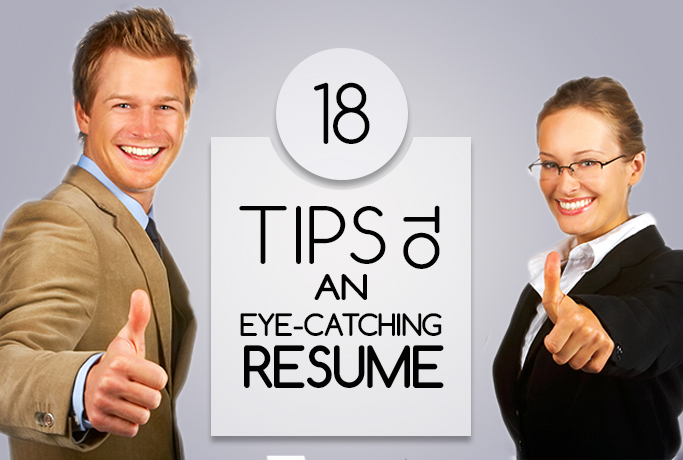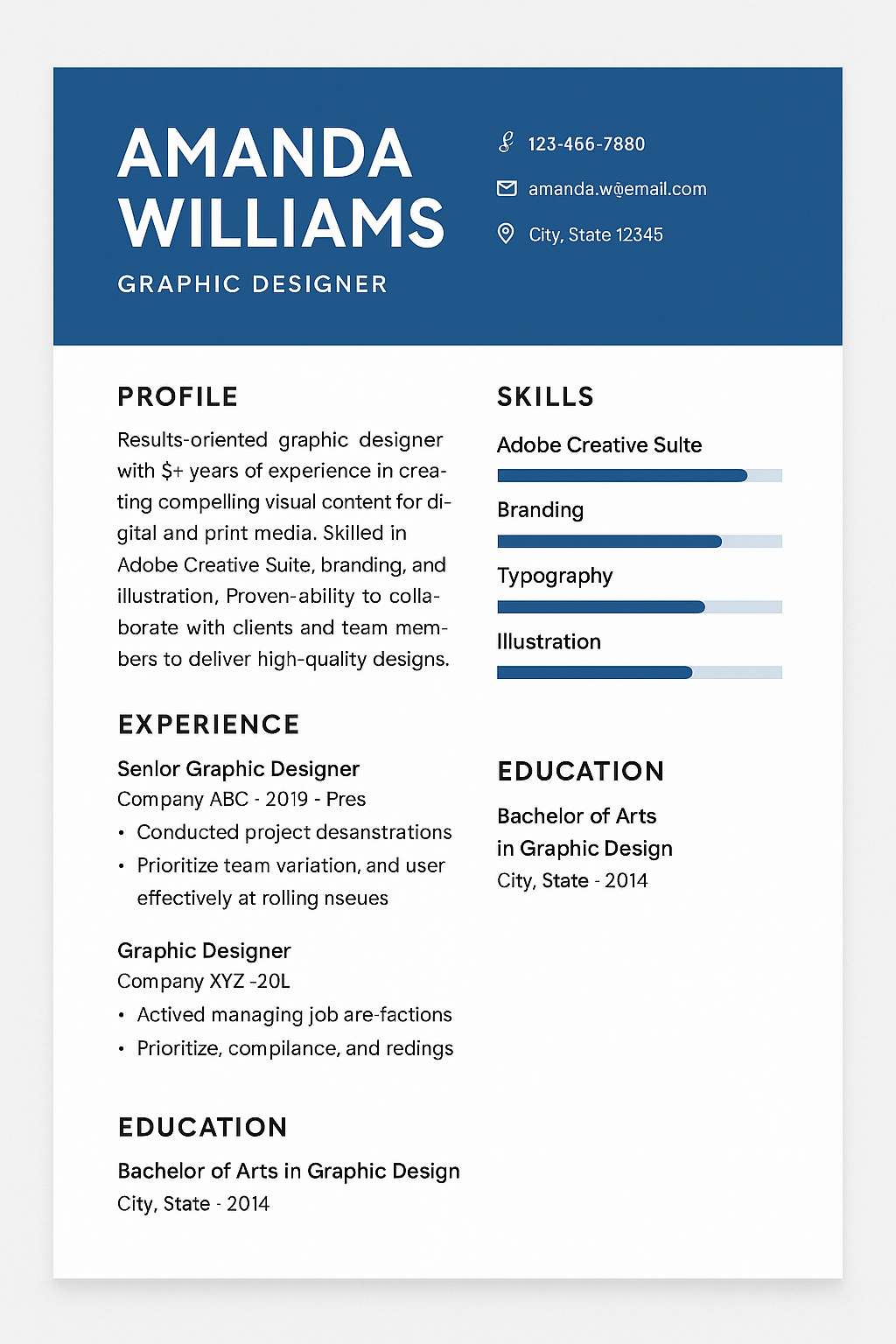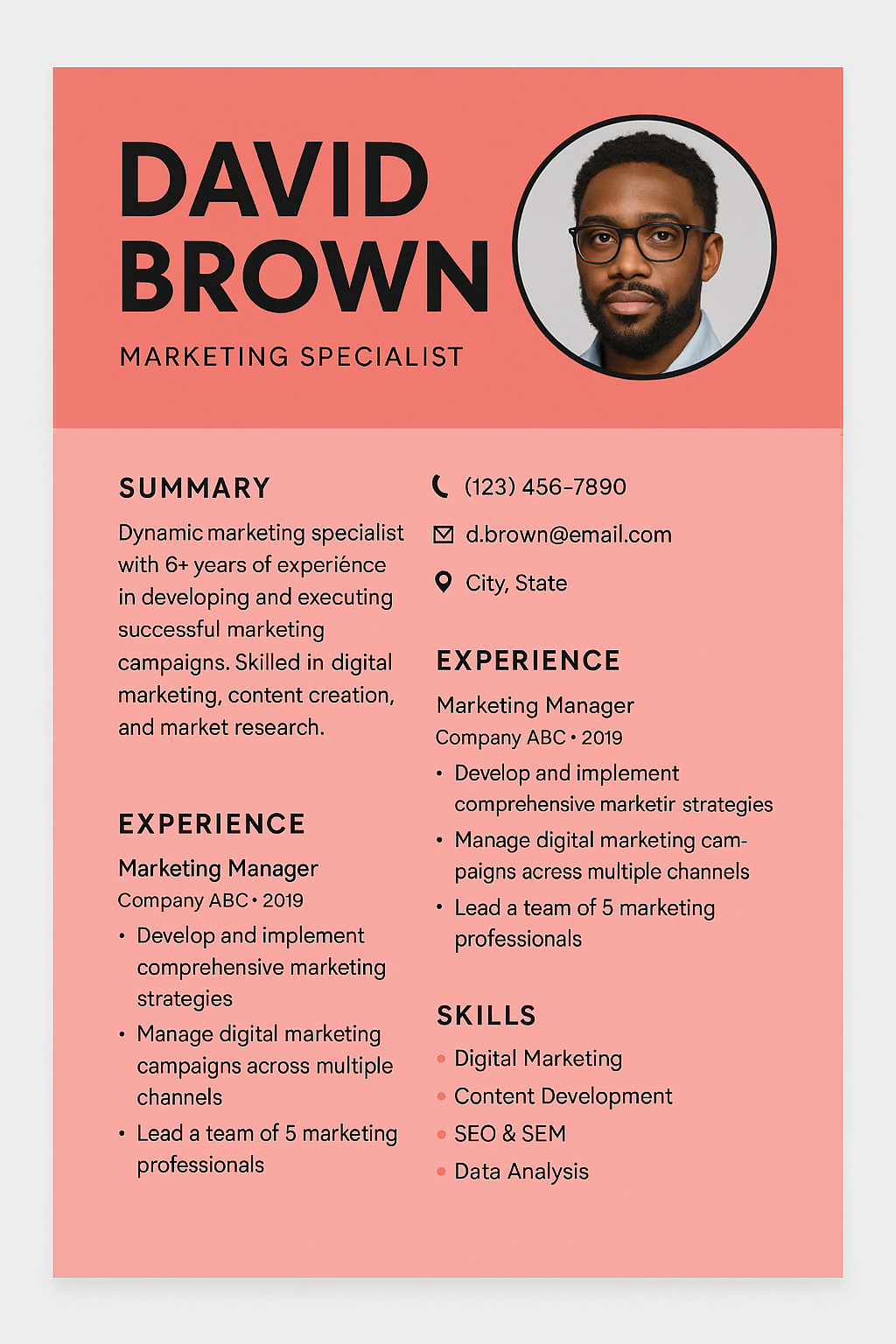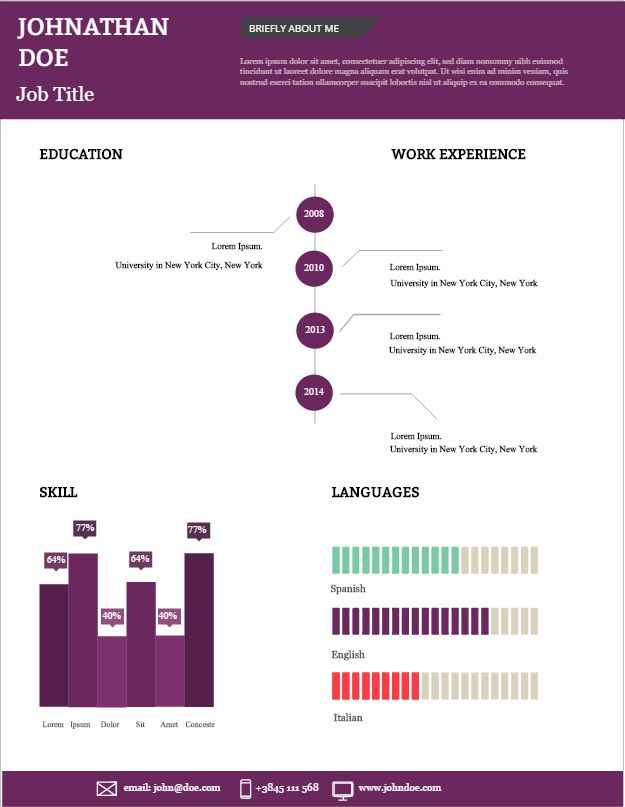How to Make Eye-Catching Resumes: 11 Practical Tips

With years of experience in resume writing and recruitment, I’ve found that visuals alone don’t make a resume eye-catching - strategy does. This guide explains how to design and write a resume that instantly draws a hiring manager’s interest. You've written your resume in accordance with all resume rules and guides. You are sure that you're 100% qualified for a job opening and possess the relevant experience. Your resume is pretty informative in terms of content and represents your professional profile. So, why aren't you invited out for a dream job interview? The problem might be that your resume isn't eye-catching.
In 2025, job seekers face fierce competition, making an eye catching resume essential. Understanding what makes a resume stand out is key to crafting a resume that gets noticed. With recruiters forming first impressions in seconds, knowing how to capture a recruiter's attention and adapt to their scan behavior can mean the difference between landing an interview or being overlooked. For this reason, it is very important to have a strong resume at the beginning of your job search efforts.
The eye-tracking study of professional recruiters proves that it's important not only WHAT you write about yourself, but also HOW and WHERE you put this information. In this entry, we are going to share some valuable tips on how to write your resume so that it would really capture the attention of the reader.
Why Do You Need an Eye-Catching Resume in 2025?
In 2025, standing out in a competitive job market means going beyond basic formatting and generic content. A resume with visual impact is more than just aesthetics—it’s about communicating your value instantly. Using effective resume attention grabbers helps transform your application into an attention grabbing resume that positions you as the ideal candidate. Here’s why an impactful resume matters for every job application document:
- Competitive Job Market Edge. An impactful resume differentiates you from hundreds of qualified candidates competing for the same role.
- Enhanced Professional Branding. Strong visuals. and content alignment reinforce your professional identity and industry expertise.
- Memorable Candidate Impression. Strategic layout and storytelling techniques help recruiters remember you after reviewing multiple applications.
- Optimized Digital Presentation. Digital-friendly formats ensure your resume looks sharp and functional on any device or platform.
- Faster Decision Influence. A well-structured, visually appealing resume helps decision-makers quickly grasp your strengths and move you forward in the process.
What Recruiters Look For in a Resume (and What to Highlight)
Understanding what recruiters look for in a resume is essential for job seekers aiming to stand out. Studies on resume scan behavior and resume eye tracking reveal that recruiters focus on clearly defined sections, making bold resume headers vital for guiding their attention. To highlight achievements on resume, use concise bullet points and measurable results. While professional resume templates offer polished layouts that capture a hiring manager's attention, even free resume templates can be effective if well-structured and tailored to the role.
According to the study mentioned above, first and foremost your potential employers are interested in
- Candidate's name
- Current job title and company
- Previous job title and company
- Previous position start/end dates
- Current position start/end dates
- Education
In addition to the above, recruiters also browse the text for keywords that should match the open position. And, if they're satisfied with what they found during this brief scanning, there's a chance that your resume will be read in a deeper detail.
How to Make Your Resume Eye-Catching (15 Expert Tips)
In 2025’s competitive job market, your resume needs to do more than list experience—it must instantly capture attention. Hiring teams value both soft skills and technical skills, but they often scan resumes in seconds. A simple resume template that works with any applicant tracking system, paired with a strong professional portfolio, can set the stage for success. Let's check the most effective tips that should be followed.
Tip 1: Use Eye-Catching Resume Templates (Visually Appealing Yet ATS-Friendly)
Choosing the right resume template is a crucial step in making your application stand out. The best resume templates for 2025 are designed to balance visual appeal with clarity, ensuring that recruiters can quickly identify your strengths. Whether you use a modern resume builder or customize a design yourself, the format should highlight both your hard and soft skills effectively, presenting you as a well-rounded candidate.
Tip 2: Optimize for Mobile and ATS
Creating a mobile-friendly resume is essential in 2025, as many recruiters review applications on their phones. At the same time, resume optimization for ATS ensures your document passes automated screening before reaching a human reviewer. Use relevant keywords that match the job description, keep the content to an appropriate length, and present your work history clearly to guide the reader’s eye. Remember, with many other candidates applying, your resume must be both readable on small screens and ATS-compliant to stand out.
Tip 3: Use the keywords in headings or subheadings
Resume headings often sound generic, such as “Career history” or “Professional experience”. It's time to rewrite those headings and make them work for you. How to make an eye catching resume? For instance, you can replace “Professional experience” with “Software development experience” or “Project management experience”. Thus, the extra key phrase given in bold will make the reader stay on the heading rather than just skip it.
Tip 4: Boldface your impact on business
Usually, people put their achievements or awards under a specific section. Generally it's correct; however, in this case the power of your achievements often gets lost among the other information. There's a way to put emphasis on your achievements and use bold formatting. Since the recruiters browse position names closely, putting your key achievement or award right after the position name, as follows:
Sales Manager – 38% sales growth during the last year
Office Manager – #2 in the overall performance rating
Tip 5: Keep the juicy information to the top of the page
What is the resume layout that attracts employers? The top half of the first page gets most of attention, so make this rule work for you. Include your achievements in the summary, put your key skills (if your job is skill-based) above the experience and other facts. Even if you've had had some serious achievements several years ago, it's still worth putting this information at the beginning of your resume as this information can become a real lifesaver.
Tip 6: Start the bullets with accomplishments or numbers
Most of the resume bullet points start this way: “Developed a policy…”, “Managed the team…” etc. Try and rewrite the bullets under the different angle. For example, instead of “Led negotiations with vendors that saved the company $70K”, use the following: “Saved $70K on operating expenses during negotiations with vendors”.
Tip 7: Center and boldface the key information
If there's a fact, achievement or an important reference that you feel can make the difference for your career, be sure not only to include it to your resume, but also put it into a visible place, boldface, or underline. If an influential person in your industry has left a positive reference about your performance, it's ok to put it at the top of your resume. Resume formatting is indeed important!
Tip 8: Use a graph or chart
If your performance had had a measureable impact on business and ensured substantial growth in sales, profitability, or client acquisition, why not present it graphically? So, how to write an eye catching resume? Add graphic design elements and highlight ther ight keywords! Thus, the recruiter won't have to search for the key information in the text and will know your capabilities at a glance. Images that demonstrate positive trends will definitely ensure that your resume will be read and give you much more chances for an interview.
Tip 9: Put the position name and key areas of expertise at the top
Instead of a mundane Objective section which isn't necessary for most resume, start your resume with stating the name of the position you'd like to obtain and 2-3 statements describing your excellence or career focus. Do not forget to use action verbs in resume! This can look as follows:
Senior Project Manager
Proactive Management – Operating Budgets – Timely Delivery
Tip 10: Keep it short and sweat
Many job-seekers who are striving to make a killer first impression (especially for management positions) put each and every achievement on the resume. As a result, each job description section looks lengthy and the recruiter doesn't feel like reading through huge blocks of text to find something worth his attention. The recommended length for each job is 4-6 bullets, 1-2 lines each (might be a little longer for CEOs). So, prioritize the information and only leave responsibilities and achievements that will be of interest for a recruiter.
Tip 11: Enrich the Summary with keywords
As we said before, what is at the top of the document gets more attention. Thus, make sure that your summary has enough keywords to motivate the HR to read on. Even if you are a recent graduate and lack relevant experience, you can use necessary keywords and connect them with your curricular or voluntary activities. Check out the blog for more resume summary tips, as this section is very important!
Tip 12: Add a short description after the company name and job title
Most people limit themselves to giving the name of the company and sometimes name of the department. However, recruiters are often interested in more details – and if they have their questions answered straightaway, such a candidate evokes trust and gets more consideration. So, be sure to include the following: company size, turnover, budget and number of people that you personally managed.
Tip 13: Update your online profile with professionally looking picture
The chart shows that recruiters spend 19% of their time looking at the profile picture when looking through LinkedIn profiles. So, make the headshot your advantage – update your profile with a picture in a professional environment, dress code, and make sure it demonstrates your positive attitude.
Tip 14: Proofread and proofread again
Mistakes grab the recruiter's attention – not in a good way. Mistakes on a resume indicate sloppiness, poor writing skills or carelessness, which isn't the impression you are looking to make. So, proofread the resume before sending it – use an online spell checker and, ideally, have someone else to review it with a fresh eye. A spotless, grammatically correct resume will be another plus for inviting you for an interview.
Tip 15: Add links to your online resources
Since the recruiters will be look up for you online anyway, why not ease their job and communicate the right impression at the same time? Along with your contact info, attach the links to your online profiles – such as LinkedIn page, personal website or professional blog, or social media in case these are professional pages. The employer will appreciate the opportunity to evaluate your background better, and you'll have a chance to show off your competencies and professional value.
Resume Structure & Formatting That Gets Noticed
A well-structured resume makes it easier for recruiters to find key information quickly and form a positive impression. While a resume formatting service can ensure professional results, understanding the basics helps you create a document that works for your goals. Applying the right resume formatting tips and resume design elements improves readability and flow. The resume achievements placement should highlight your most relevant wins early, while an effective resume layout design follows a logical sequence. For resume styling for career changers, emphasizing transferable skills and a clear career narrative is essential.
Main sections in recommended sequence
- Contact Information: Name, phone, email, and optional LinkedIn or portfolio link.
- Professional Summary: Brief, targeted overview of your value proposition.
- Key Skills: A mix of technical and soft skills tailored to the job.
- Work Experience: Reverse chronological resume achievements placement with measurable results.
- Education: Degrees, certifications, and relevant training.
- Additional Sections: Awards, publications, languages, or volunteer work, if applicable.
Common Mistakes That Make Resumes Invisible
Want to follow the eye catching rule and keep good resume visibility? Then learn what NOT to include in your CV. Too much colors, strange fonts or “funny” photos can kill that eye-catching look you wanted. Remember, even an eye-catching design won’t help if content looks unprofessional or overloaded with useless details.
Bonus: Examples of Eye-Catching Designs
Looking for some eye catching resume examples? Here you can find fresh and creative ideas that make your CV stand out from boring ones. From clean minimal layouts to bold graph resume design ideas, you will see styles that HRs remember. Want to try it yourself? Just download eye-catching resume sample and edit it easy. Or use our resume builder templates to make design in few minutes – no special skills needed. Play with fonts, colors, shapes, but keep it still professional. A good visual touch can be that little thing that gets your resume on top of the pile. It should not necessarily be a one page document or have a two column layout. The choice is all yours!


Choose a style to make your resume eye-catching
The design of your resume plays an important role in getting your resume noticed. In addition to perfecting the content, you need to pick the right resume style that helps you win the recruiter's attention. Need some inspiration? Take a look at the samples of resume styles below.
Vibrant resume template
Infographic resume are taking over, and this resume style is a great example how to make your resume bright while keeping it concise and professional. This kind of resume shows your career progression, skills and summarize your key career milestones using minimum text.

Image source: https://www.easel.ly/blog/wp-content/uploads/2015/10/53.jpg
Monochrome resume example
Want to make your resume look classy but would like to go away from traditional ‘black text on a white background' format? Then, this resume style is a great way to go. It's easy on the eye and gives your resume a fresh, modern look while keeping the structure and color choices conservative.
Retro resume style
Retro typographic is a great way to add a playful element to your traditional resume. Thanks to its unusual style, a retro resume is a great way to distinguish from traditional word and infographic resumes. This resume looks pretty much like a traditional text resume, yet is easy on the eye and communicates all key details.
Will the above tips help me to get an interview?
Yes! If you do everything right and showcase your major achievements and capabilities by putting them on the most visible place, you'll get noticed for sure. However, if after rewriting your resume and making it eye-catchy you are still not getting interview calls, there must be a problem somewhere else. For instance, you are not qualified enough for the position, or your resume is ATS-unfriendly. To understand the weak points of your resume (and to correct them), you can take the advantage of free resume critique service. Talk with our career expert on chat now and learn how to present yourself as a strong candidate on your resume!
Is your resume designed in a way that captures the attention of the reader at the first glance? Why?
Author: Editorial Team at ResumePerk.com
Reviewed by: Certified Career Expert
Last updated: October 2025
Recommended reading:


